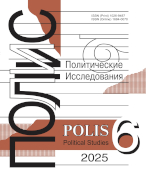Dynamics of political electoral preferences among residents of closed cities in Russia (1995-2003)
Article received: 2022.05.30. Accepted: 2023.08.18

DOI: 10.17976/jpps/2024.01.09
EDN: KFBTNY
Tarasenko G.K. Dynamics of political electoral preferences among residents of closed cities in Russia (1995-2003). – Polis. Political Studies. 2024. No. 1. https://doi.org/10.17976/jpps/2024.01.09. EDN: KFBTNY (In Russ.)
The article was prepared in the framework of a research grant funded by the Ministry of Science and Higher Education of the Russian Federation (grant ID: 075-15-2022-325). The author gratefully acknowledges feedback from Olga Malinova and participants of the “Academic Writing” course at the Graduate School of Political Science (HSE University, Spring 2021), as well as from Timur Natkhov, Kyle Markquardt, and Kirill Shamiev.
This study explores the political aspect of closed cities, which is understudied compared to their managerial and economic aspects. The author examines the association between the status of a closed city and political preferences in 1990s. The study suggests that closed cities were strongholds of both liberal and anti-communist voting. It also hypothesizes that the differences in political preferences between closed cities and the rest of Russia diminish over time. The author collects electoral data from 1995 to 2003 and employs regression analysis, finding support for these hypotheses. However, the effect of voting for the “party in power” varies depending on the specific party project. This research contributes to understanding the political uniqueness of closed cities, considering their regional characteristics and social capital.
References
Abramson, P.R., & Inglehart, R. (1987). Generational replacement and the future of post-materialist values. The Journal of Politics, 49(1), 231-241. https://doi.org/10.2307/2131142
Batorova, D. (2010). Social’naja transformacija byvšich” zakrytych territorij” v Estonii na primere Paldiski i Sillamjae. Diplomová práce. Univerzita Karlova, Fakulta sociálních věd, Katedra ruských a východoevropských studií.
Brock, G. (1998). Public finance in the ZATO archipelago. Europe-Asia Studies, 50(6), 1065-1081. https://doi.org/10.1080/09668139808412581
Cianetti, L., Dawson, J., & Hanley, S. (2018). Rethinking “democratic backsliding” in Central and Eastern Europe–looking beyond Hungary and Poland. East European Politics, 34(3), 243-256. https://doi.org/10.1080/21599165.2018.1491401
Doll, C. N., Muller, J. P., & Morley, J. G. (2006). Mapping regional economic activity from night-time light satellite imagery. Ecological Economics, 57(1), 75-92. https://doi.org/10.1016/j.ecolecon.2005.03.007
Ekiert, G., & Kubik, J. (1998). Contentious Politics in New Democracies: East Germany, Hungary, Poland, and Slovakia, 1989–93. World politics, 50(4), 547-581. http://www.jstor.org/stable/25054056
Enikolopov, R., Petrova, M., & Zhuravskaya, E. (2011). Media and political persuasion: Evidence from Russia. American Economic Review, 101(7), 3253-3285. https://doi.org/10.1257/aer.101.7.3253
Fisher, S.D. (2004). Definition and measurement of tactical voting: the role of rational choice. British Journal of Political Science, 34(1), 152-166. https://doi.org/10.1017/S0007123403220391
Gentile, M. (2004). Former closed cities and urbanisation in the FSU: an exploration in Kazakhstan. Europe-Asia Studies, 56(2), 263-278. https://doi.org/10.1080/0966813042000190533
Godoy, S., & Stiglitz, J. E. (2007). Growth, initial conditions, law and speed of privatization in transition countries: 11 years later. In Transition and Beyond: Essays in Honor of Mario Nuti (pp. 89-117). London: Palgrave Macmillan UK. https://doi.org/10.1057/9780230
Guriev, S.*, & Treisman, D. (2019). Informational autocrats. Journal of Economic Perspectives, 33(4), 100-127. https://doi.org/10.1257/jep.33.4.100
Havrylyshyn, O., & McGettigan, D. (2000). Privatization in transition countries. Post-Soviet Affairs, 16(3), 257-286. https://doi.org/10.1080/1060586X.2000.10641488
Hale, H.E. (2009). The myth of mass authoritarianism in Russia. Public Opinion Foundations of a Hybrid Regime. URL: https://www.ucis.pitt.edu/nceeer/2009_823-03_Hale.pdf
Henderson, J.V., Storeygard, A., & Weil, D.N. (2012). Measuring economic growth from outer space. American Economic Review, 102(2), 994-1028. https://doi.org/10.1257/aer.102.2.994
Homeland, G., & Jorgensen, A.K. (1998). Closed cities on the Kola Peninsula: from autonomy to integration? Polar Geography, 22(4), 231-248. https://doi.org/10.1080/10889379809377655
Hillygus, D.S. (2005). The missing link: exploring the relationship between higher education and political engagement. Political Behavior, 27(1), 25-47. https://doi.org/10.1007/s11109-005-3075-8
Hünermund, P., & Louw, B. (2020). On the nuisance of control variables in regression analysis. arXiv preprint arXiv:2005.10314.
Ivanov, D. (2016). Human capital and knowledge-intensive industries location: evidence from Soviet legacy in Russia. The Journal of Economic History, 76(3), 736-768. https://doi.org/10.1017/S0022050716000802
Kolossov, V., Vizgalov, D., & Borodulina, N. (2003). Voting behaviour in Russian cities, 1995–2000. Journal of Communist Studies and Transition Politics, 19(4), 25-40. https://doi.org/10.1080/13523270300660027
Natkhov, T., & Pyle, W. (2023). Revealed in transition: The political effect of planning’s legacy. European Economic Review, 159, 104567. https://doi.org/10.1016/j.euroecorev.2023.104567
Turchenko, M., & Golosov, G. V. (2021). Smart enough to make a difference? An empirical test of the efficacy of strategic voting in Russia’s authoritarian elections. Post-Soviet Affairs, 37(1), 65-79. https://doi.org/10.1080/1060586X.2020.1796386
Tansel, C.B. (2018). Authoritarian neoliberalism and democratic backsliding in Turkey: Beyond the narratives of progress. South European Society and Politics, 23(2), 197-217. https://doi.org/10.1080/13608746.2018.1479945
Turovsky, R., Koroteeva, P.P., & Rusanova, K.A. (2020). Nationalization of Russia’s Party System: Local Dimension and Regional Patterns. Higher School of Economics Research Paper No. WP BRP, 72. https://doi.org/10.2139/ssrn.3524884
Gelman, V.Ya. (2008). Political parties in Russia: from competition – to hierarchy. Polis. Political Studies, 5, 135-152. (In Russ.)
Gelman, V.Ya. (2019). “Nedostoinoe pravlenie”: politika v sovremennoi Rossii [The politics of bad governance in contemporary Russia]. St. Petersburg: EUSP Press. (In Russ.)
Golosov, G.V., & Liechtenstein, A.V. (2001). The “power parties” and the Russian institutional design: theoretical analysis. Polis. Political Studies, 1, 6-14. (In Russ.)
Lappo, G., & Polian, P. (1998). Closed cities in Russia. Socilogical Studies, 2, 43-48. (In Russ.)
Phaykov D.Yu. (2010). Closed administrative-territorial entity as a field of state’s interests. Problemnyi analiz i gosudarstvenno-upravlencheskoe proektirovanie, 3(2), 111-115.
See also:
Polyakov L.V.,
Russians electoral behaviour. – Polis. Political Studies. 2011. No6
Filippov Yu.M.,
Electoral Behaviour of the Electors to the State Duma of the Beginning of the 20th Century 142. – Polis. Political Studies. 2003. No4
Round Table of the «Polis» Journal, Rakitiansky N.M., Smulkina N.V., Palitay I.S., Zatonskikh A.V., Evgenyeva T.V., Selezneva A.V., Cherdantzeva A.M., Nikiforov A.R., Bogdan I.V., Ahmatnurova S.F., Samarkina I.V., Bukreyeva O.V., Shestopal E.B., Shcherbinin A.I., Shcherbinina N.G., Yanitzky M.S., Titov V.V.,
Political behavior: unconscious mechanisms and their rationalization. – Polis. Political Studies. 2013. No6
Polyakov L.V.,
Decline of plebiscitary democracy?. – Polis. Political Studies. 2014. No2
Bykov I.A., Hall T.E.,
Digital divide and the Internet-users political preferences in Russia. – Polis. Political Studies. 2011. No5




.jpg)






 print
print
.jpg)
.jpg)